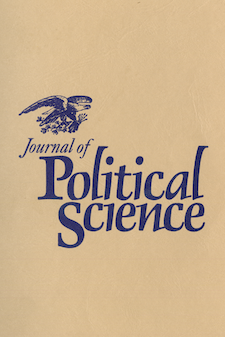Volume 27, Number 1 (1999)
Preface
Special Issue Theme: Metropolitan Change
The U.S. Census Bureau identifies a metropolitan area as large population core with adjacent communities having a high degree of economic and social integration with the core population. While metropolitan areas represent only 19% of the U.S. land area, almost 80% of the U.S. population live in metropolitan areas. The growing metropolitan population includes significant demographic changes. While, for example, South Carolina's Afro-American population will increase by the year 2000 by more than 4% over 1995 levels, the same five-year period will see the state's Hispanic population increase by 14%, to a population of 42,000.
Historically, metropolitan growth and changing demographic patterns have changed political institutions. As immigration earlier provided the incentive for political machines and machines, in turn, stimulated progressive reforms, the infusion into the south of different cultures both from other states and from other cultures will alter traditional notions of the appropriate role and scope of government. Dissatisfaction with centralization in any form – political, economic, and religious—and the subsequent devolution of responsibilities to local organizations will result in heightened responsibilities for local service delivery, both public and private. Distinctions between government provided and government-required services and those services co-produced by voluntary organizations (neighborhood upkeep and crime reporting, for example) may redefine the boundary between political resources and the citizen, the private sector and private citizens, voluntary organizations and public institutions. Regional subcultures (Hispanic, Afro-American, urban) will result in different patterns of social and political needs that may exacerbate conflict among minority groups. Added to an already complex mix is the increase in foreign investment in southern states and information technologies that easily outstrip the social restraints imposed by traditional institutions.
This volume of The Journal of Political Science examines some of the issues confronting metropolitan areas: the problems posed by restrictive state laws, the need for greater resources and coordination of service delivery, the effect of population change on metropolitan expenditures, and the social and political consequences of population growth.
Professors Jane McCollugh and William V. Moore of the College of Charleston examine the efforts of one city, Charleston, South Carolina, to expand its resource base to compensate for declining inner-city population. They conclude that aggressive annexation policies and the willingness to test the limits of the law can overcome South Carolina 's restrictive annexation statutes. Between 1960 and 1998, the City of Charleston grew from about 6 square miles to almost 40 square miles, thus broadening its tax base and providing one of the bases for Charleston's urban revival.
Metropolitan areas can also meet the challenges of service delivery and resource needs through consolidation of city and county governmental operations. Professors Linda S. Johnson and Richard C. Feiock of Florida State University examine the consolidation efforts of nine cities across the United States and Canada, with particular emphasis on consolidation efforts in Tallahassee, Florida. Using a framework earlier developed by Rosenbaum and Kammerer. In addition to citizens' perceptions of community crisis, the inability of government to deal effectively with the crisis, and a precipitant event providing impetus to consolidation efforts, they conclude that political, civic, and academic elites can provide a critical component in successful consolidation campaigns.
The electoral implications of metropolitan change are explored by Professors Chris Grant and Jon Baggett of Presbyterian College. They examine recent state-wide elections in South Carolina attempting to offer an initial explanation as to why the voters of South Carolina, seemingly the most republican electorate in the country, choose to re-elect in 1998 both a democratic United States Senator, Ernest Hollings, after a near defeat in 1996 and the state's first democratic governor, Jim Hodges, since 1982. While cautioning that one election does not establish a trend, they identify demographic and regional electoral trends that have led to a resurgence of the Democratic Party in South Carolina.
While suicide does not at first appear connected to metropolitan political change, Professor Friedrich V. Wenz of the University of South Carolina Spartanburg provides a reminder that metropolitan growth may have surprising consequences: high suicide rates in counties with populations of under 25,000. The reasons for this surprising finding include a dispersion of population from urban to rural areas, institutional overload, and cultural clash. These possibilities may have significant effects on the provision of urban and rural service delivery, and the nature of governmental service, itself.
Any discussion of metropolitan growth and development would be incomplete without a discussion of municipal expenditures. Dr. Barbara L. Neuby of the State University of West Georgia correlates population growth rates with municipal expenditures. She concludes that the connection between expenditures and population growth is not easily described and that expenditures are not predicted by population growth, alone.
Together, these articles provide a partial picture of the complex politics of metropolitan governance. Continued metropolitan growth and the concomitant racial and ethnic diversity, increased attention to issues of gender, and higher expectations for government services coupled with demands for lower taxes combine to ensure that the challenges of metropolitan change will command a substantial portion of the political agenda for the opening decades of the next century.
Dwight Lambert
Articles
Exercising Dominion over Metropolitan Growth: A Case Study of Charleston, South Carolina
Jane McCollough and William V. Moore
Revolutionary Change in Local Governance: Revisiting the Rosenbaum and Kammerer Theory of Successful City-County Consolidation
Linda S. Johnson and Richard C. Feiock
Every Which Way and Loose: The Changing Suburban and Urban South Carolina Electorates
Chris Grant and Jon Baggett
Suicide in South Carolina
Friedrich V. Wenz
Demographic Change and Municipal Expenditure, 1980-1990
Barbara L. Neuby
Book Reviews
Book Review: Citizenship: Feminist Perspectives by Ruth Lister
Ashlie Lancaster
Book Review: Why Wars Happen by Jeremy Black
Conway Henderson

Editors
- Managing Editor
- Dwight Lambert
Additional Information
Published for the South Carolina Political Science Association by the University of South Carolina Spartanburg Department of Political Science.

